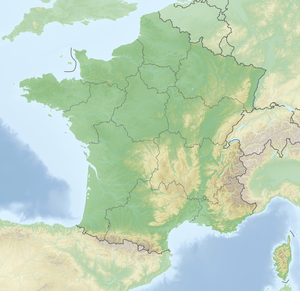Zola dam
| Zola dam | |||
|---|---|---|---|
|
|
|||
|
|
|||
| Coordinates | 43 ° 31 '56 " N , 5 ° 30' 41" E | ||
| Data on the structure | |||
| Lock type: | Arch dam | ||
| Construction time: | 1847-1854 | ||
| Height of the barrier structure : | 24.5 m | ||
| Data on the reservoir | |||
| Water surface | 4 ha | ||
| Storage space | 2.5 million m³ | ||
The Zola dam (French barrage Zola ) is one of the earliest arch dams and possibly the first modern arch dam on earth. It stands in the French commune of Le Tholonet in the valley of the Infernet river, below the newer and larger Bimont dam . Between 1854 and 1877 the dam and the associated canal were used to supply Aix-en-Provence with drinking water. Its builder François Zola (1795-1847) was an engineer of Italian descent and the father of Émile Zola .
history
The plan to build a dam has its origins in the worldwide cholera epidemic from 1832 to 1835. It came to Aix in 1834/35 and again in 1837. It was then decided to tackle the problem of supplying the city with clean drinking water . The project was approved by the City Council of Aix en Provence on February 25, 1837. François Zola then planned his project of the dam with a 7 km long canal to carry the water into the city.
After various administrative difficulties, the project was accepted on April 19, 1843. The royal approval came on May 31, 1844 and work began in 1847. François Zola did not live to see the completion because he died on March 27, 1847 of pneumonia that he picked up on the construction site.
The journal Le petit provençal reported in its edition of July 29, 1847: “Yesterday […] were Adolphe Thiers and Antoine Aude, Mayor of Aix, Borely, Advocate General, Goyrand, his deputy, Leydet, justice of the peace, and various other dignitaries of the city came unexpectedly to visit the work on the Zola Canal on the Infernet. They found themselves in the midst of huge explosions that the workers had prepared. M. Pérémé, the manager, benefited from the circumstances and introduced Zola's young son to Monsieur Thiers. "
After the early death of François Zola, his company for the construction of the canal (Société du canal Zola) was persecuted by creditors represented by Jules Migeon. In 1852 the company was bankrupt, in 1853 it was taken over by Migeon. Zola's widow now had to live on a meager pension.
The structure was put into operation in 1854. The name barrage Zola was given to the building on September 17, 1871, in honor of its designer.
use
The dam was used until 1877. After that, water was diverted through the Canal du Verdon . Today it no longer has a water supply function, but it is used to dop the water levels in the Cause and Arc rivers .
Others
Paul Cézanne depicted the Zola Dam in a painting in 1877/78. The work was acquired by the Welsh art collector Gwendoline Davies . It has been in the National Museum Cardiff since 1952 .
See also
- List of the largest dams on earth
- List of the largest reservoirs on earth
- List of the largest hydroelectric plants in the world
- List of dams in the world
literature
- Jean-Louis Bordes: Les barrages-réservoirs en France du milieu du XVIIIe siècle au début du XXe siècle , 2005, ISBN 2859784039
Web links
- François Zola Dam structurae.de
- Le barrage Zola près d'Aix-en-Provence Planète TP
- Barrages Bimont et Zola Grand site Sainte-Victoire
Individual evidence
- ↑ Zola. Panorama d'un auteur , Marie-Aude de Langenhagen, Gilbert Guislain, Ed. Studyrama, 2005, p. 18.
- ^ Cézanne: The François Zola Dam museumwales.ac.uk



